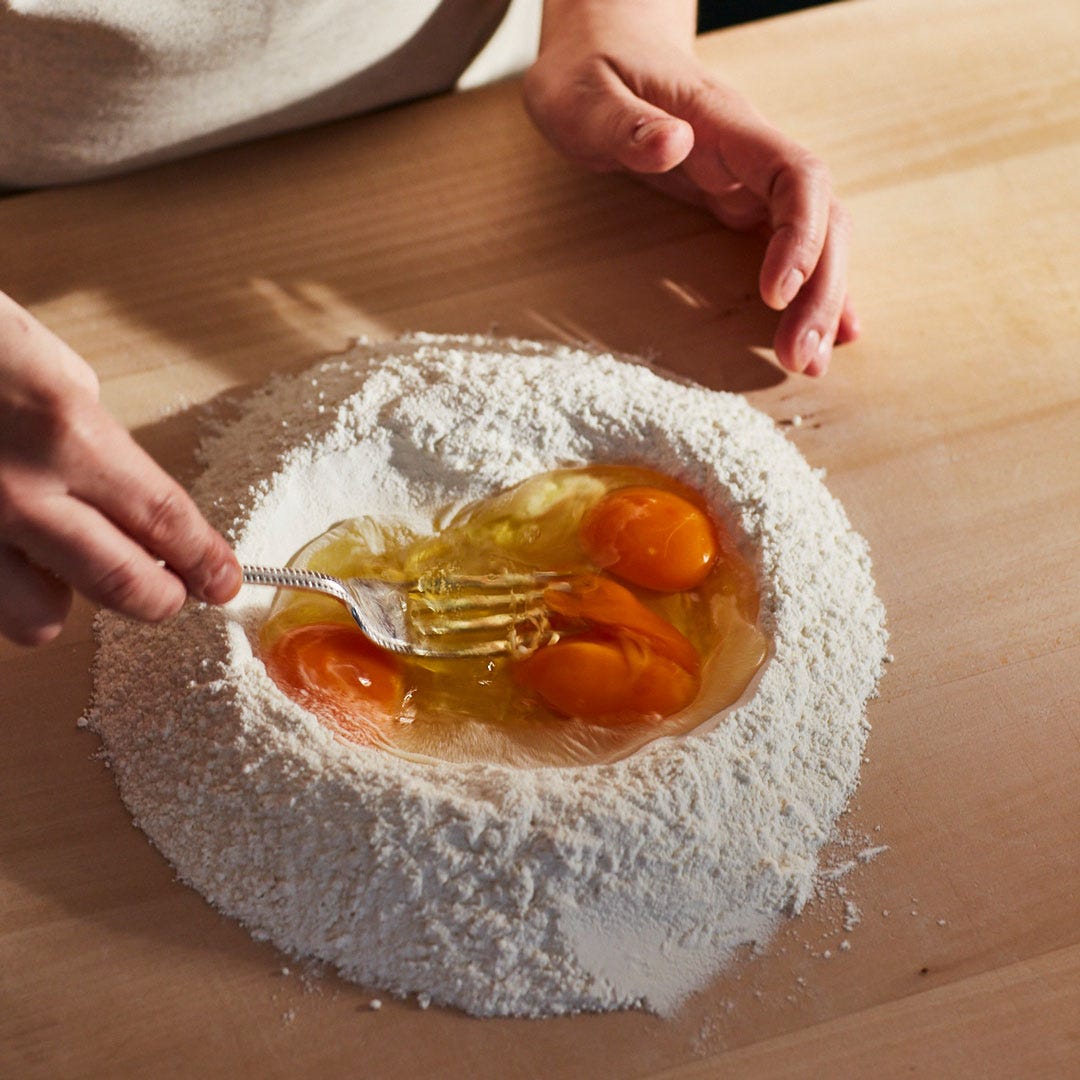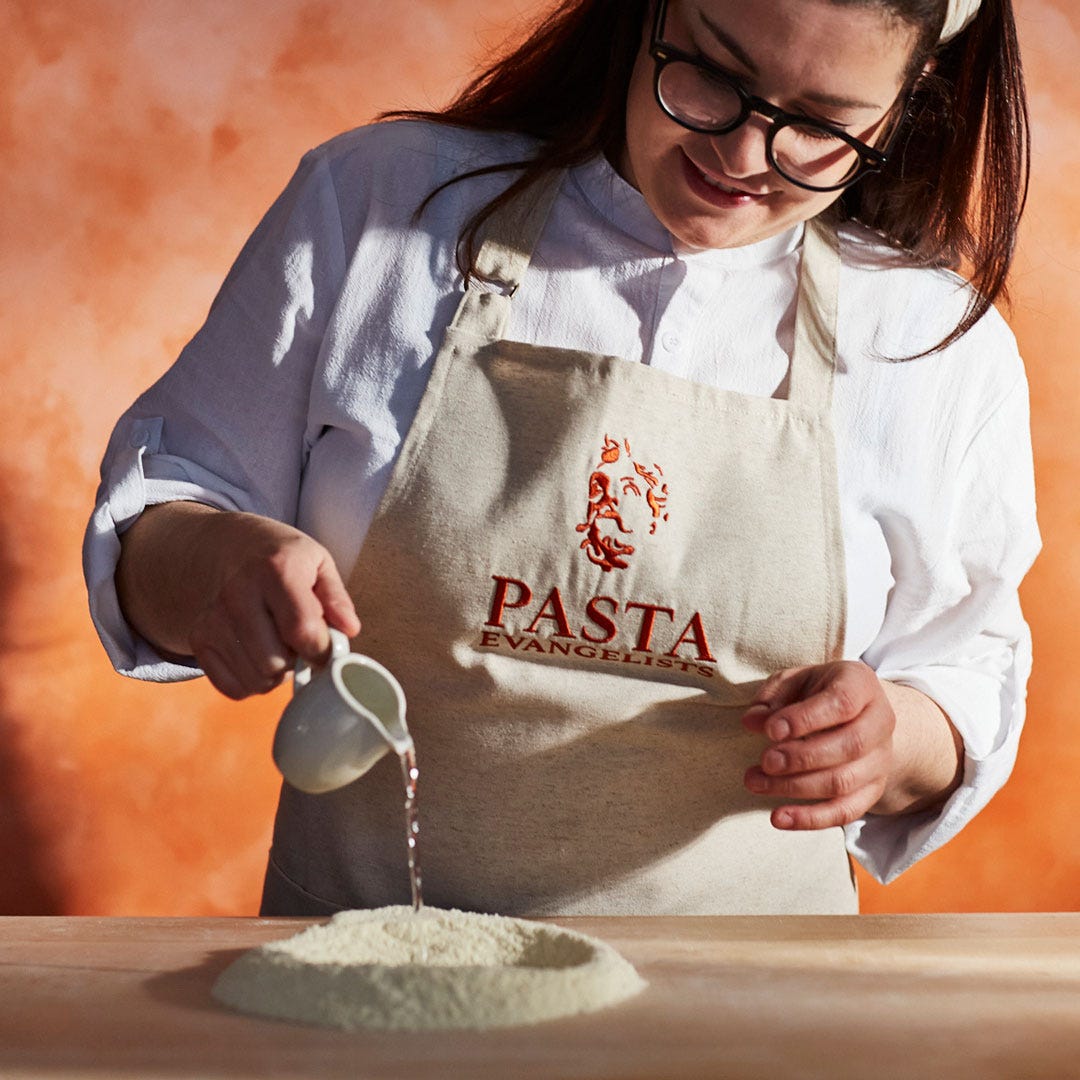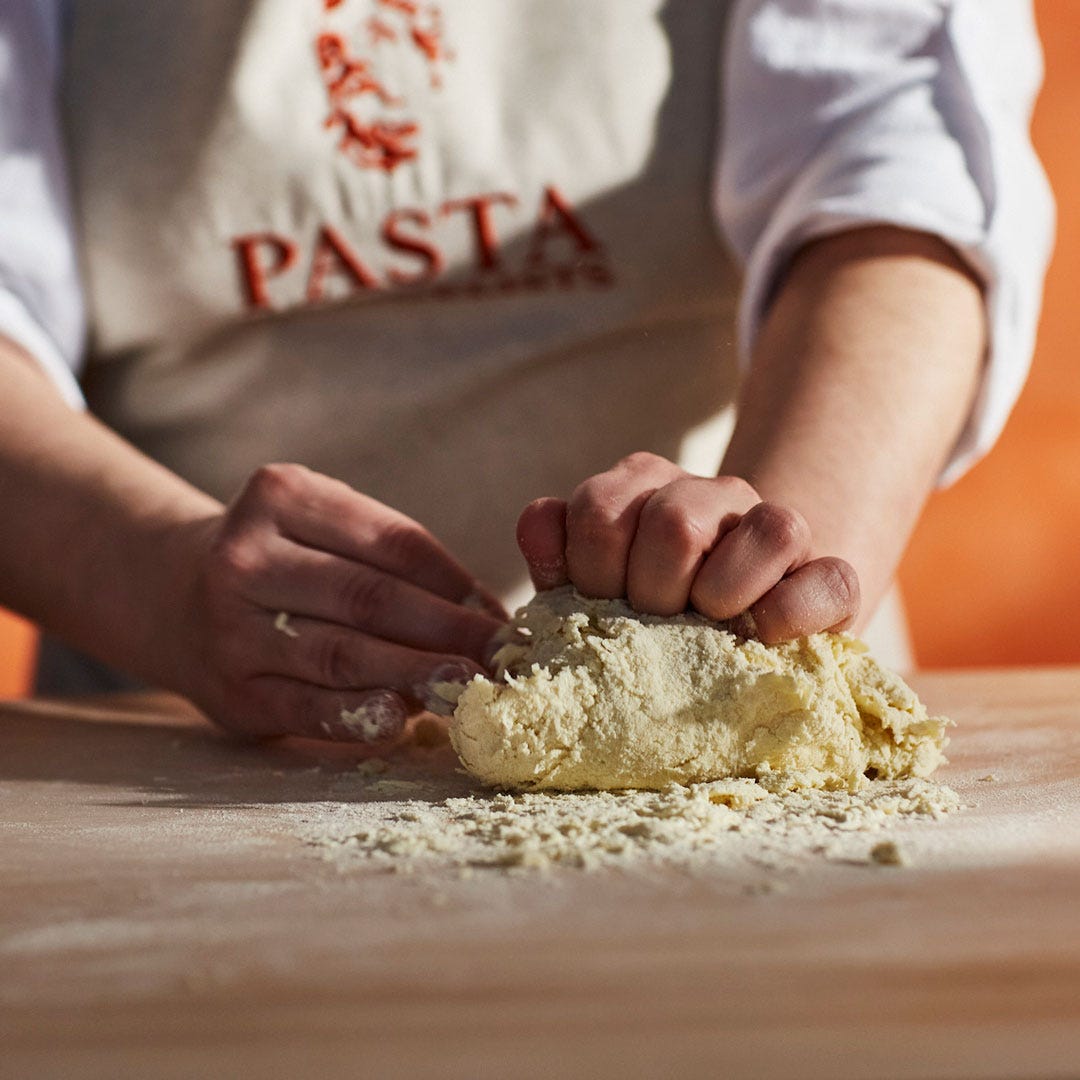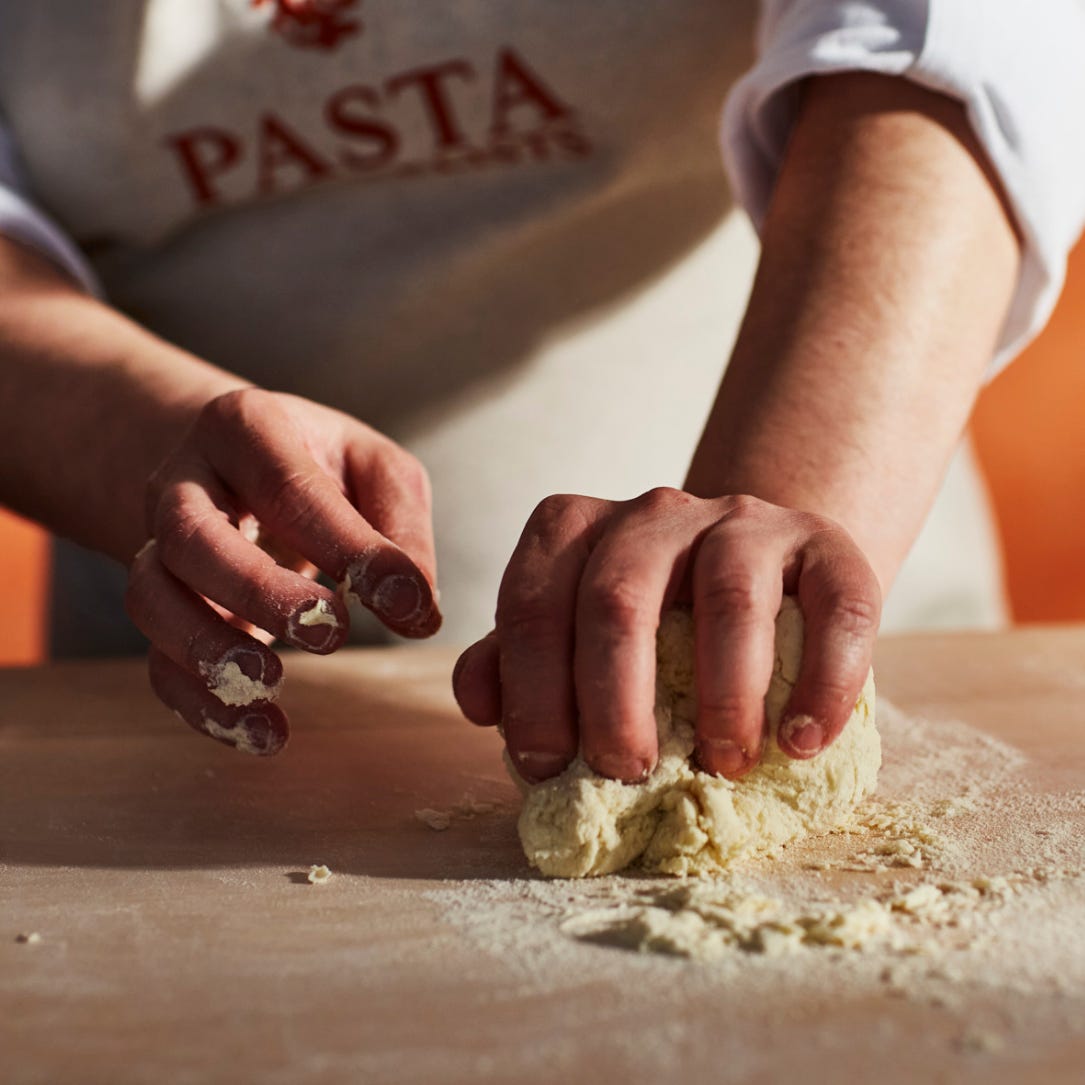Welcome to The Pasta Academy Newsletter, from Chef Roberta d’Elia and the team at Pasta Evangelists. Subscribe today to get the newsletter sent to your inbox every other Monday.
As I tell every guest at my pasta masterclasses, making fresh pasta is an art – but it’s an art that anyone can master. Of course, knowing how to roll and shape a myriad of different pasta shapes is a skill that comes with practice. But the foundation of all good pasta is a good dough, something that’s a lot easier than it sounds (I promise).
The pasta-making process only ever calls for a couple of ingredients: flour and egg in the case of pasta all’uovo (egg pasta), or flour and water for pasta bianca (white pasta). Because of this, picking the right ingredients is vital – as is measuring them.
On flour: For fresh egg pasta you need doppio zero, or ‘00’ flour, made from soft wheat. ‘00’ flour is much finer than plain flour and so is perfect for making a dough that can be rolled into very thin sheets. You should be able to find ‘00’ flour in all the big supermarkets.
For a flour and water dough (common across southern Italy) you need semola di grano duro, which is finely milled semolina flour. People often mix this flour up with regular semolina, which is a completely different product. I order semola online (my favourite brand is Divella).
On eggs: The fresher your eggs, the better your results. Unless you’ve got access to your own laying hens or a nearby farmers market, your best option in the UK is the wonderful Burford Brown variety sold by the specialists at Clarence Court, which have reliably golden yolks. Thankfully, these are now widely available in supermarkets.
On quantities: For a classic egg pasta dough, I stick to a ratio of 1 large egg and 100 grams of flour per person. For a flour and water dough, it’s 50ml of water and 100 grams per person. The two recipes below both serve four people, so just scale the quantities up or down to suit you.
Egg pasta dough (pasta all’uovo)
This is the pasta dough of choice across northern Italy, but particularly in places like Bologna, where the windows of pastifici (pasta shops) are piled high with pasta shapes rolled out that very day, ready to be sold by weight to hungry locals.
What you need:
400g ‘00’ pasta flour
4 large eggs
A wooden board or work surface
A fork
Use this dough to make: Filled pastas like ravioli, tortellini or agnolotti; sheets of pasta for lasagne or cannelloni; longer ribbons like pappardelle, fettuccine or tagliatelle; some shorter shapes like farfalle and garganelli.
Method
Make a well: On a clean wooden or marble work surface, pile the flour into a mound. Using your fist, make a wide well in the centre of the mound (a little like a volcano crater), then crack your eggs in.
Start mixing: Beat the egg mixture with a fork, slowly pulling the flour from the sides of the well until the egg has all been absorbed by the flour.
Bring it all together: As the mixture thickens, start using your hands to continue incorporating the flour. If your dough looks dry, add a drop or two of warm water and continue mixing with your hands until you have a ball of dough.
Get ready to knead: Clean the work surface of any excess flour or dough bits that weren’t incorporated, then lightly flour your clean work surface.
Knead the dough: Place your ball of dough on your work surface, then knead it, pressing the heel of one hand into the ball and keeping your fingers high. Press down on the dough while pushing it firmly away from you – the dough should stretch and roll under your hand to create a shell-like shape. Turn the dough over, then press into it with your knuckles, one hand at a time. Repeat this process around 10 times.
Knead the dough (again): Form your dough back into a ball and repeat the stretching and knuckling process, using more flour if needed to prevent any stickiness. Repeat the process for about 10 minutes until the dough is smooth and springy to the touch, then roll it into a ball.
Let the dough rest: Place the dough in a small bowl and cover with a cloth or plastic wrap, then let it rest for at least 30 minutes at room temperature, or up to a day in the fridge. If you refrigerate your dough, let it stand at room temperature for at least an hour before using.
Flour & water pasta dough (pasta bianca)
In Puglia, where I’m from, pasta bianca – a ‘white dough’ made from flour and water – is the traditional choice for pasta making, reflecting the fact that southern Italy has long been an impoverished region where eggs were once an unaffordable luxury. They’re much easier to come by these days, but the tradition lives on in pastas like orecchiette – meaning ‘little ears’ – which is my favourite shape (and the first I learned to make).
What you need:
400g semola di grano duro
200g lukewarm water
A pinch of salt
A wooden board or work surface
A fork
Use this dough to make: Smaller, hand-dragged shapes like orecchiette, trofie, cavatelli and malloreddus, as well as thin strands like spaghetti and linguine. This dough isn’t suitable for making filled pastas like ravioli – it lacks the resistance of an egg-rich dough and may fall apart*.
*There’s one exception to this rule: culurgiones (a unique stuffed pasta from Sardinia) are in fact traditionally made with a flour and water dough. But that’s a story for a future post…
Method
Make a well: On a clean wooden or marble work surface, mix your flour and salt together and pile it into a mound. Using your fist, make a wide well in the centre of the mound and then gently pour half of the water into the well. (I only add half initially because the flour can sometimes absorb the humidity in the room, meaning the full 200ml of water isn’t always needed).
Start mixing: Using a fork, gradually add the flour to the water, slowly incorporating the flour from the sides of the well until all of the water has been absorbed by the flour.
Bring it all together: Continue slowly adding more of the warm water and mixing with your fork until the mixture thickens. Once it does, use your hands to form the mixture into a shaggy ball of dough.
Get ready to knead: Clean the work surface of any excess flour or dough bits that weren’t incorporated, then lightly flour your clean work surface.
Knead the dough: Place your ball of dough on your work surface, then knead it, pressing the heel of one hand into the ball and keeping your fingers high. Press down on the dough while pushing it firmly away from you – the dough should stretch and roll under your hand to create a shell-like shape. Turn the dough over, then press into it with your knuckles, one hand at a time. Repeat this process around 10 times.
Knead the dough (again): Form your dough back into a ball and repeat the stretching and knuckling process, using more flour if needed to prevent any stickiness. Repeat the process for about 10 minutes until the dough is smooth and springy to the touch, then roll it into a ball.
Let the dough rest: Place the dough in a small bowl and cover with a cloth or plastic wrap, then let it rest for at least 15 minutes at room temperature, or up to a day in the fridge. If you refrigerate your dough, let it stand at room temperature for at least an hour before using.
Thanks for reading The Pasta Academy Newsletter, from Chef Roberta d’Elia and the team at Pasta Evangelists. Subscribe today to get the newsletter sent to your inbox every other Monday.













